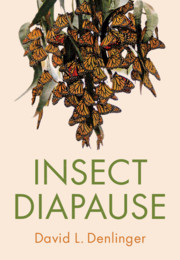Book contents
- Insect Diapause
- Insect Diapause
- Copyright page
- Dedication
- Contents
- Preface
- 1 Confronting the Challenges of a Seasonal Environment
- 2 Which Seasons Are Being Avoided?
- 3 Variation in the Diapause Response
- 4 The Cost of Diapause and Some Diapause Alternatives
- 5 Interpreting Seasonal Cues to Program Diapause Entry
- 6 Preparing for Diapause
- 7 The Diapause State
- 8 Ending Diapause and Reinitiating Development
- 9 Molecular Signaling Pathways that Regulate Diapause
- 10 Genetic Control of Diapause
- 11 Evolution of Diapause
- 12 Wider Implications
- References
- Species Index
- Subject Index
- Plate Section (PDF Only)
5 - Interpreting Seasonal Cues to Program Diapause Entry
Published online by Cambridge University Press: 13 January 2022
- Insect Diapause
- Insect Diapause
- Copyright page
- Dedication
- Contents
- Preface
- 1 Confronting the Challenges of a Seasonal Environment
- 2 Which Seasons Are Being Avoided?
- 3 Variation in the Diapause Response
- 4 The Cost of Diapause and Some Diapause Alternatives
- 5 Interpreting Seasonal Cues to Program Diapause Entry
- 6 Preparing for Diapause
- 7 The Diapause State
- 8 Ending Diapause and Reinitiating Development
- 9 Molecular Signaling Pathways that Regulate Diapause
- 10 Genetic Control of Diapause
- 11 Evolution of Diapause
- 12 Wider Implications
- References
- Species Index
- Subject Index
- Plate Section (PDF Only)
Summary
To use information inherent in the seasonal change in daylength, an insect must be able to measure daylength, distinguish long from short days, count the days, store that information in the brain, and then act on that information at the correct developmental stage to engage the diapause program. This chapter explains the nature of the photoperiodic signal, when it is received, where this information is stored, and how that information triggers the hormonal response. Formal models and molecular approaches examining the role of circadian clock genes consistently point to a circadian basis for the photoperiodic clock. Thermoperiod sometimes substitutes for photoperiod, suggesting alternative pathways for evoking the diapause program. Some tropical insects rely exclusively on temperature or rainfall as environmental signal regulating diapause. Input from hosts can also be important for plant-feeders and parasitoids. The diapause decision is sometimes relegated to the mother, thus requiring an intriguing mechanism for the transfer of environmental information across generations.
Keywords
- Type
- Chapter
- Information
- Insect Diapause , pp. 57 - 120Publisher: Cambridge University PressPrint publication year: 2022
- 2
- Cited by



